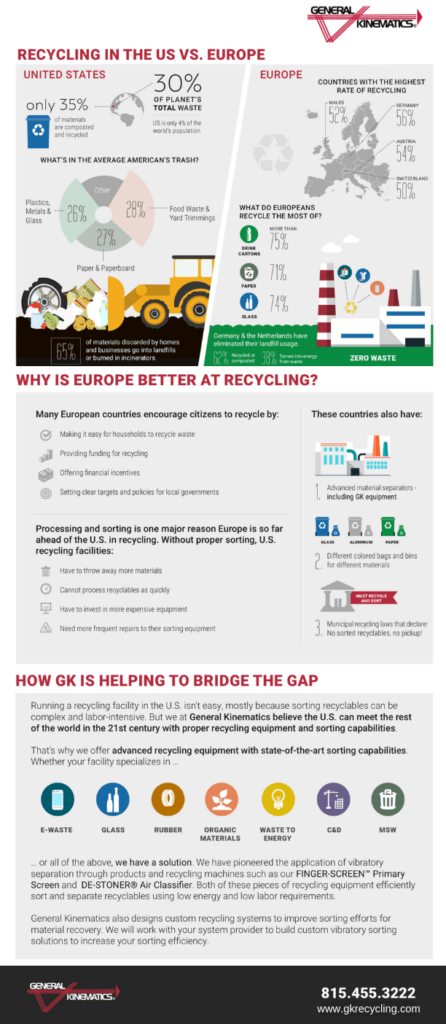In our already-climate-disrupted world, we are inundated with petro-based plastics. We could rehash the numerous statistics that we probably already know, like the fact that only 9 percent of plastic waste in the U.S. actually gets recycled or that we all have microplastics in our stomachs or that making plastic products from recycled plastics actually uses 66 percent less energy than using virgin polymers. But we all know most of these stats. The question is “what are we going to do about it?”
Obviously, the recycling system in the U.S. isn’t adequate. How might it be improved?
Improving U.S. Recycling Rates
The entire industrialized world doesn’t suck at recycling; German, for instance, has a municipal solid waste (MSW) recycling rate of 68 percent. However, one of the most powerful nations in the industrialized world does. Though the U.S. represents just 4 percent of the global population, it generates 35 percent of the planet’s waste.
The good news is that the U.S. is better at it than it was in the past. As of 2017, the U.S. was recycling over 35 percent of its MSW, compared to just 6 percent in the 1960s. While about 50 percent of the waste that gets recycled is paper and paperboard, only 3.4 percent is plastic. (Worth noting is that, in 2010, over 50 percent of U.S. MSW consisted of compostable materials. Though these materials could be composted at home or through municipal programs, their decomposition in landfills leads to methane emissions, in part causing landfills to represent 20 percent of the country’s methane production. Aerobic composting does not result in methane release, so just by composting food waste, you can reduce GHG emissions.)
To get up to the levels achieved by Germany and Austria (another leader in the recycling race), it has been suggested that the U.S. make very clearly demarcated waste receptacles with a wider range of categories easily accessible by the public across the country, as well as in individual homes. Germany has bottle recycling machines located at most grocery stores throughout the country. South Korea and Hong Kong have battery and electronic disposal bins at train stations and other public locations.
Greater education about what can and cannot be recycled (e.g., cereal boxes vs. greasy hamburger wrappers) and how to prepare items for recycling (e.g., thorough cleaning of food debris) can improve recycling rates by causing less issues at the recycling plant. According to Waste Management, the largest processor of residential recycling in North America, 25 percent of items sent for recycling should actually be trashed. However, China’s Green Fence policy now requires only 0.5 percent contamination, leading the country to reject many more recycling shipments than historically accepted.
In addition to improved education and public waste sorting options, there are policy options that can be utilized to increase recycling rates. In many European countries, such as Switzerland, recycling is free, but garbage disposal costs money. In Germany, retailers and manufacturers have to pay for a green dot on their packaging with more packaging leading to more fees, incentivizing businesses to reduce the amount of packaging they use.
New Methods of Recycling
In addition to improving the rates of recycling in arguably the most consumer-driven country on the planet, there are new ways of recycling that can reduce waste overall. For instance, faster and more accurate sorting technology could make the process more efficient. This is one technology that claims to do just that, though we cannot vouch for its efficacy.
There are also natural methods for processing waste. For instance, phytoremediation relies on plants to remove, degrade or contain contaminants in soil, sludge, sediments and water. In the Netherlands, one company has used biological treatment to clean water, ultimately reducing water use by 50 percent. Cereol in Germany relies on enzymes to degum vegetable oil as a replacement for potentially dangerous acids or large amounts of water, thus reducing water use by 92 percent and waste sludge by 88 percent.
There is currently research underway to apply similar principles to plastics. A team at Kyoto University, for instance, has isolated a bacteria that can digest PET. Yale researchers have discovered a species of fungi that can digest polyurethane.
As we discussed in our posts on polyhydroxyalkanoates (PHA) and other bioplastics, it’s possible to generate polymers from bacteria. We can even envision the possibility of creating a circular economy in which bacteria are used to digest waste to create new usable biopolymers. In our next post, we will discuss the concept of a circular economy in greater depth, including such possibilities.
[Feature image courtesy of RitaE on Pixabay.]Subscribe to Our Email Newsletter
Stay up-to-date on all the latest news from the 3D printing industry and receive information and offers from third party vendors.
Print Services
Upload your 3D Models and get them printed quickly and efficiently.
You May Also Like
Nikon SLM Solutions Sells SLM 500 to Primary Weapon Systems to Expand Suppressor Production
Primary Weapons Systems (PWS) is a Boise, Idaho-based manufacturer of suppressors, firearms, and related components. A subsidiary of Vigilant Gear and a sister company to aftermarket Glock slide manufacturer Lone...
3DPOD 261: Tooling and Cooling for AM with Jason Murphy, NXC MFG
Jason Murphy´s NXC MFG (Next Chapter Manufacturing) is not a generalist service; instead, the company specializes in making tooling. Using LPBF and binder jet, the company produces some of the...
HP and Firestorm Labs Form Partnership to Use Multi Jet Fusion 3D Printers in Deployable Factories
HP Inc., maker of a range of additive manufacturing (AM) solutions including the Multi Jet Fusion (MJF) ecosystem, has announced a partnership with Firestorm Labs, a developer of containerized, deployable...
3D Printing News Briefs, July 2, 2025: Copper Alloys, Defense Manufacturing, & More
We’re starting off with metals in today’s 3D Printing News Briefs, as Farsoon has unveiled a large-scale AM solution for copper alloys, and Meltio used its wire-laser metal solution to...


































